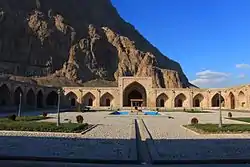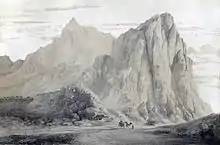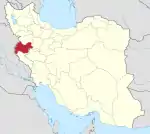Bisotun
Persian: بيستون | |
|---|---|
City | |
 | |
 Bisotun | |
| Coordinates: 34°23′55″N 47°26′38″E / 34.39861°N 47.44389°E[1] | |
| Country | |
| Province | Kermanshah |
| County | Harsin |
| District | Bisotun |
| Population (2016)[2] | |
| • Total | 4,942 |
| Time zone | UTC+3:30 (IRST) |
Bisotun (Persian: بيستون; also Romanized as Bīsotūn; also known as Bīsītan and Bīsītūn)[3] is a city in, and the capital of, Bisotun District of Harsin County, Kermanshah province, Iran.
At the 2006 census, its population was 2,075 in 527 households.[4] The following census in 2011 counted 5,107 people in 1,427 households.[5] The latest census in 2016 showed a population of 4,942 people in 1,495 households.[2]
The town is at the foot of Bisotun Mountain, the flank of which is the location of an important historical site. The imperial road from Ekbatana to Babylon passed at the foot of the mountain. On the rocky slopes king Darius I left the Behistun Inscription. From the Seleucid epoch there is a Herakles statue. Next to it Parthian kings added some reliefs. Late Sasanian rulers prepared a large piece of rock for another victory relief which was never finished because of the subsequent Arab invasion. Later folklore connected this place to the legend of Farhad and Shirin.
A Safavid caravanserai is preserved in Bisotun.

![]() Media related to Bisotun at Wikimedia Commons
Media related to Bisotun at Wikimedia Commons
References
- ↑ OpenStreetMap contributors (13 July 2023). "Bisotun, Harsin County" (Map). OpenStreetMap. Retrieved 13 July 2023.
- 1 2 "Census of the Islamic Republic of Iran, 1395 (2016)". AMAR (in Persian). The Statistical Center of Iran. p. 05. Archived from the original (Excel) on 3 April 2022. Retrieved 19 December 2022.
- ↑ Bisotun can be found at GEOnet Names Server, at this link, by opening the Advanced Search box, entering "-3056492" in the "Unique Feature Id" form, and clicking on "Search Database".
- ↑ "Census of the Islamic Republic of Iran, 1385 (2006)". AMAR (in Persian). The Statistical Center of Iran. p. 05. Archived from the original (Excel) on 20 September 2011. Retrieved 25 September 2022.
- ↑ "Census of the Islamic Republic of Iran, 1390 (2011)" (Excel). Iran Data Portal (in Persian). The Statistical Center of Iran. p. 05. Retrieved 19 December 2022.
